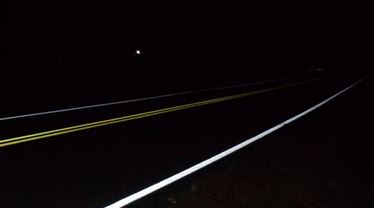A study showing how the N.C. Department of Transportation was able to reduce serious crashes after rural roads were striped with long-life lane markings has garnered national attention.
The Federal Highway Administration and the Roadway Safety Foundation honored the NCDOT with a 2021 National Roadway Safety Award during a virtual ceremony broadcast from Washington, D.C. this week.
The award recognizes the results of a pilot in which the department used thermoplastic lane markings, which are more durable and better at reflecting headlights, thanks to embedded glass beads in the plastic paint. The newer material was applied to 400 miles of rural, two-lane roads across the state between 2014-2017.
“Safety is our top priority, and we are continuously evaluating new initiatives that will result in fewer crashes and traffic deaths,” NCDOT Secretary Eric Boyette said. “I’m proud of my team. It’s quite a distinction for their efforts to be recognized by the Roadway Safety Foundation and the Federal Highway Administration.”
The department found a statistically significant 13% reduction in lane-departure crashes, such as vehicles veering off the roadway, after the long-life markings were added to the roadway. The higher-quality lane markings help drivers better navigate the roads and curves, particularly at night or in the rain. In some cases, the department also applied 6-inch-wide lane markings, instead of the standard 4 inches, to improve visibility.
The NCDOT was one of seven National Roadway Safety Award winners announced today. The awards were first presented in 1999 and have been given every two years to recognize roadway safety achievements that move the nation toward zero deaths and serious injuries.
More than half of crashes in North Carolina that kill or seriously injure people involve vehicles departing their lanes. The department focused the pilot on rural, two-lane roads because they disproportionately represent a large share of such crashes. One of the main reasons is that North Carolina has one of the nation’s highest number of vehicle miles traveled over rural, two-lane roads.
State Traffic Engineer Kevin Lacy said long-life pavement markings are 40% more expensive than traditional roadway paint, but they are more visible at night and in the rain, and they last between five years and seven years, compared with the average two-year cycle of regular paint.
“This is a proactive and systemic approach to enhancing safety that yielded a demonstrable crash reduction,” Lacy said.
The department has spent $64 million on thermoplastic markings over secondary roads between 2015and 2019. Lacy said the department will continue to invest in long-life lane markings.


